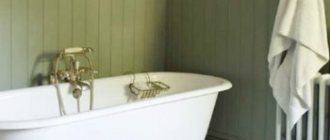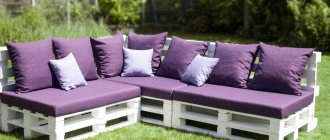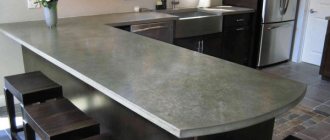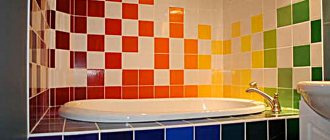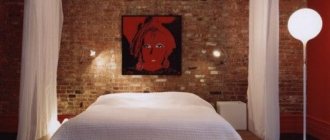Who doesn’t dream of finding themselves in the warm shower of hot equatorial latitudes instead of taking a shower? A new piece of plumbing - a tropical shower, simulating the flow of rain in your shower stall or bathtub, can give you such sensations. Manufacturers of such shower systems are vying with each other to promote the beneficial therapeutic effect of such a procedure, but what will such pleasure cost? Or maybe home craftsmen are able to independently build a water supply system no worse than the factory one?
Description
The new “tropical” shower is simply a wide watering can in various designs, located fixedly above the person. Unlike inexpensive options, high-quality products allow you to distribute the water flow evenly over the entire area of the shower head. Formally, a tropical shower is a whole plumbing system consisting of not only a watering can, but also a mixer. A real rain shower is equipped with a system for mixing water with air inside the shower head; this effect is achieved using special grilles or other structural elements inside the plumbing element.
Popular manufacturers of hygienic showers
In the ranking of the best manufacturers, the leading positions are occupied by manufacturers from Germany. The Grohe and Hansgrohe brands have gained particular popularity.
Grohe BauCurve 123072 is a built-in model with a single-lever mixer and chrome finish. To place it you will need two holes in the wall. The flexible hose allows you to choose the location relative to the toilet, placing the faucet and watering can in different places.
Grohe BauEdge 23757000 is another model equipped with one lever for adjusting water pressure and temperature. Connects to the sink.
Lemark Solo LM7165C is a built-in bidet model with a brass body. The watering can holder and the mixer are combined into one common element, which is mounted on the wall.
Hygienic shower Lemark Solo LM7165C.
Oras Saga 3912F - model connected to the washbasin. Single lever mixer, installed horizontally, chrome plated.
Therapeutic effect
The positive effect of a continuous flow of water in “tropical shower” systems has been used in sanatorium and medical institutions for quite a long time. Typically, the use of tropical systems involves the use of different temperatures, as well as light and color therapy, the beneficial effects of music and even aromatherapy. The shower itself has a relaxing and light massage effect; drops of water, falling from a great height under the influence of natural gravity, gently envelop the skin, allowing the body to relieve the stress of a tiring day. A cool shower with medium-strong jets, on the contrary, can set the body up for active activity, and a more powerful water pressure tone the muscles.
Rain shower: types and manufacturing features
The simplest water supply device in the style of equatorial rain is a wide nozzle on a shower hose measuring 15 cm or more. Manufacturers provide many options to suit every taste and budget; the most complex and expensive models are equipped with a mechanism for regulating the water supply, but such watering cans can only be called a tropical shower conditionally. More expensive rain effect systems, in addition to the watering can, include a durable wall stand, the quality of the parts of such products is slightly higher, and some companies produce real works of plumbing art.
Many manufacturers offer a prefabricated system with a mixer; the latter, however, is not very different from standard models for bathtubs. For those who want to fully experience the effect of the “tropical shower” system in the bathroom, and the types of simple transformations of the shower head do not suit them, they produce shower wall panels or special installations with mounting to the ceiling. Such options look very impressive if they are built flush with the ceiling and equipped with additional LED lighting, which in some models is mounted directly into the shower head.
Varieties
In addition to the fact that the rain shower built into the ceiling is significantly different from the standard one, it has several modifications. Equipped with various additional functions:
- The simplest model. There are no additional functions and only two operating options: drops or streams of water.
- Hydromassage models. They differ in the number and size of nozzles. At a certain position of the mode switch, the jets will be strong enough to provide a massage effect.
- Illuminated options. A small generator and several LEDs are built inside the diffuser. When a stream of water passes through the generator, it produces energy, causing the LEDs to glow. In addition to the generator, a small temperature sensor is often built in, which causes the diodes to glow differently depending on the water temperature. Such a shower not only looks very beautiful, but also has a special effect of light, called chromotherapy.
- Large models equipped with the “fog” or “steam” function - the names are different, but the essence is the same - through very small nozzles, water is sprayed in the form of a tiny water suspension that envelops you in a cool or hot cloud. The feeling is simply indescribable and very pleasant.
Otherwise, different models differ only in size and installation complexity - some options are much easier to install than others. The presence of additional functions also affects this - the more there are, the more difficult it will be to install. The easiest way to get a rain shower in the ceiling is to buy a more modern shower cabin - all the necessary parts are already built into the top panel and all you have to do is connect the cabin to a water source, and in some cases you may need to connect it to the mains. It is better to entrust these works to professionals, as there is a risk of doing something wrong and getting injured from an electric shock.
Water pressure
Before installing equipment such as a tropical shower in your bathroom, you need to calculate the efficiency of water flow. As is clear from the size of the shower head, the consumption can be significant. The plumbing system must provide a sufficient amount of water for the tropical shower system to fully operate. As practice shows, the pressure requirements of wide shower heads are not too different from ordinary ones. There are water consumption standards for manufacturers of plumbing equipment, both Russian and foreign, which are not too different. The maximum water flow is regulated by filters or limiters built into the equipment, but what about the minimum values? For a high-quality rain shower system to fully operate, a pressure of at least 2 atmospheres is required, but you do not need complex measuring equipment. You just need to take a stopwatch and a container with a volume you know. For a soft shower, depending on the size of the nozzle, a flow of 5-7 liters per minute is sufficient, while for powerful jets you will need 9-15. If your system can provide such volumes, you can safely proceed to installing shower equipment. Otherwise, you need to increase the water pressure in the system by cleaning and replacing pipes, removing restrictors or installing special pressure pumps. In city apartments, such issues must be resolved by building management structures or water suppliers; water supply standards established by the state are quite capable of coping with a tropical rain shower system.
Methods for installing a hygienic shower
By following the instructions, you can install the shower yourself.
Regardless of the type of device, before connecting it to the water supply system, it is necessary to perform the following preparatory work:
- Choose a location. The installation height of the mixer and watering can above the floor should be such that a person can easily reach them without standing up. The watering can holder can be mounted above the toilet.
- Depending on the location of the pipelines, it is necessary to mark the wall for laying the pipes.
- If hidden installation of hygienic shower elements is carried out, it is necessary to ditch the walls.
Hygienic shower mixer on the wall.
All further actions depend on the type of device.
Wall installation
The wall-mounted version is installed in 2 ways: open and closed. The first one is much easier and cheaper. To implement the second, you will have to make a niche in the wall for laying hot and cold water supply pipelines, then carry out the cladding.
Connection diagram for a hygienic shower.
To install a shower, you need to shut off the liquid supply in the apartment, and then install tees in the pipes. Through one of the three tee pipes, hot and cold water will flow into the mixer.
Installation of the bidet cover
After purchasing a new bidet seat, you need to remove the old lid from the toilet by unscrewing the plastic wings.
Before connecting the bidet lid to the pipeline, you need to close the shut-off valve on the line leading water to the toilet cistern. The line is then removed and a tee is installed. It has three pipes, two of which are equipped with internal threads, and one with external threads. The pipes with internal threads are placed vertically: the line leading to the toilet tank is connected to the upper one, and the lower one is connected to the water supply network. The remaining one is used to attach the bidet lid to the tee.
Sink installation
If there is a sink near the toilet, then you can install a hygienic shower in the toilet yourself.
Installation of a hygienic shower.
To do this you need to purchase the following items:
- Mixer.
- The hygienic shower itself and everything that comes with it is standard: studs, nuts and O-rings.
- Hoses.
- Shut-off valves.
- Keys.
Installation is carried out as follows:
- A description of all elements is given in the product instructions. Therefore, before proceeding with installation, it is recommended to carefully study it.
- After installing all the necessary gaskets according to the instructions, you need to check their tightness. If the fasteners are not tight, the system may leak in the future.
- Then install three flexible hoses. Two of them deliver hot and cold water to the faucet, and the third goes from the faucet to the shower head. A watering can is connected to its free end.
- Now start assembling the holder. The distance between it and the toilet should be such that you can take out the watering can and hang it on the holder without getting up.
- After all work is completed, open the water supply and check the system for leaks. If everything is done correctly, they will not exist. If a leak is detected, the corresponding components are dismantled and the condition of the gaskets and seals is checked.
The process of installing a shower under the sink can be seen in the video below.
Replacing the watering can
The simplest and most cost-effective option for transforming your bathtub or shower into a source of equatorial shower is to replace the shower head with a special wide model. Of course, it will be difficult to achieve the full effect, but you can refuse the services of specialists. Additional materials may require plumber's sealing tape to seal threaded connections, but usually the rubber gaskets included with the purchased nozzle can cope with any leaks without additional effort.
Installing a hygienic shower for a toilet: installation methods and nuances
To carry out all necessary hygiene procedures comfortably, it is very convenient to use a bidet. But not every bathroom will fit a separate plumbing element.
To solve this problem, a hygienic shower was invented , which is mounted near the toilet or built into it .
Let's look at how you can turn an ordinary toilet into a comprehensive hygienic device.
What are the advantages of a hygienic shower?
Let's first figure out why this equipment is installed. Water treatments are an integral part of the daily self-care routine of every tidy person. And for especially clean people, taking a shower after each visit to the toilet is a mandatory process.
If we are talking about a bathroom of sufficient size, then installing a bidet would be an acceptable option. Another thing is small-sized rooms, where installing two plumbing fixtures is simply impossible. In such cases, owners think about purchasing a compact hygienic shower.
In the case of a combined bathroom, at first glance there is no problem - the toilet is located in the same room as the bathtub or shower. However, it is much faster and more convenient to carry out hygienic care right on site. For a separate bathroom, a hygienic shower is almost mandatory - so as not to walk from one room to another, especially if more than two people live in an apartment or house.
For clarity, let’s make a list of the advantages of such a device as a hygienic shower for the toilet:
- space saving - indispensable for rooms of limited area;
- saving time spent on personal hygiene;
- cost savings - installing a hygienic shower will cost less than purchasing a separate bidet;
- it is much more convenient to clean the toilet;
- using a hygienic shower you can quickly wash a child’s potty or cat litter box;
- sanitary care for young children is facilitated;
- hygienic shower is convenient for older people;
- Using modern models with additional functions, you can even save on toilet paper and napkins.
↑
Hygienic shower options
- Shower toilet. This device is a toilet with a built-in nozzle located directly on the toilet body or on a pull-out fitting.
shower toilet with built-in nozzleTo supply water, a separate hose is installed, as well as a mixer, which can be included with the device or purchased separately.
- Bidet lid. The lid with a built-in shower can be installed on any toilet model and is mobile, which will be very convenient when changing your place of residence. These covers are available in electric and non-electric types.
bidet lidThe main disadvantage of the former is the inability to use a hygienic shower during a power outage. Bidet lids are often equipped with additional functions - water heating and even a hairdryer.
- Wall mounted shower. To install such a system, you need to purchase a faucet without a spout. Please note that a hygienic shower differs from a regular shower - it has a smaller shower head, which is necessarily equipped with a shut-off valve. If you are installing a hygienic shower during the renovation of a bathroom, do not forget to provide additional cold and hot water. When installing the device on an existing toilet, use a tee with an outlet to the cold water supply pipe, to the toilet and to the shower.
Hygienic shower with wall mountingA heater with a thermostat can be built into the shower head. You set the temperature once and never return to the question of setting the water again. The hygienic shower comes with a wall holder, and it can be hung at a certain distance from the mixer for ease of use.
- Hygienic shower with sink. If the bathroom area allows, the best option would be to install a small sink with a special mixer, including a watering can and a hose for a hygienic shower. The fact is that turning off the shut-off valve on the watering can after using the device is not enough - you still have to turn off the water on the mixer.
If the faucet has a spout, then you will definitely not forget to lower the lever - after all, when you turn off the shut-off valve, water will flow from the spout into the sink. An additional advantage will be the presence of a washbasin in the toilet.
a mixer with a thermostat for a hygienic shower , watch the video:
↑
Homemade options
Home craftsmen are ready to use their skills wherever possible, and can build a rain shower from scrap materials. A DIY watering can to achieve the effect of a rain stream is easily made from an optical disc container designed for 10 pieces. A plastic adapter to the shower hose is installed in the center of the base, the central axis of the discs is removed, and holes are marked and pierced on the upper surface of the cover: from 20 to 40 pieces. All joints and fastenings must be sealed, and a piece of rigid tube or a bracket with thick wire can be used as a holder.
Depending on your resourcefulness and availability of materials, you can implement other options for the “tropical shower” system with your own hands. What can it be made from, if not from standard plastic pipes completely and even backlit? This design involves a complete replacement of the watering can with several adjacent pipes with holes for water. The manufacture of such a structure will require at a minimum pipe connection skills, as well as other construction skills and knowledge in the field of electricity. It is difficult to judge how profitable it is to use several pipes instead of a common collector for all nozzles, and the setup of home-made systems is limited by the capabilities of the mixer.
Rack, panel and faucet
Installing plumbing fixtures such as a rain shower with faucet or a custom wall panel should not be a problem for experienced DIYers, except when installing new or additional pipes into the wall. The stand or panel is securely attached to the wall using hidden screws, the mixer can be installed in place of the old one, fortunately, standard sizes are used in almost all models. It is better to carry out pipe laying work at the stage of repairing the room.
Construction of a shower room
The thorough construction of a “tropical shower” type shower requires hidden wiring of water-bearing pipes, especially since installing a nozzle at ceiling level will also bring additional labor and material costs. Such bathroom equipment is very dependent on construction experience and the availability of plumbing skills; experts recommend entrusting the design and execution to professionals. If you feel able to handle all the steps of installing a rain shower yourself, the following are step-by-step instructions.
Construction stages
One of the main steps to fulfilling the idea is purchasing the necessary equipment and planning. There is no point in saving on plumbing components; after the work is completed, it will be problematic to make adjustments; you must be confident in the equipment. The ideal purchase option would be models from well-known brands; manufacturers value their reputation and monitor the quality of their products. Reasonable design can also eliminate possible problems in the future; access to the main components should be considered in order to replace them in the event of a breakdown without dismantling the covering of the walls and ceiling. Another condition for achieving the maximum effect from a rain shower will be a ceiling height of at least 2.3 m.
The next step is to clean the old wall coverings and, if necessary, the ceiling and floor.
After transferring the drawings from paper directly to the walls and ceiling, you can begin laying pipes. The ideal option is to cut grooves under the pipes; this installation method will save as much space as possible in the room. It is possible to equip a separate shower area from moisture-resistant plasterboard, then the pipes can be “hidden” directly into the partition. Entrance doors should be considered; for example, when installing models on casters, you need to strengthen the floor covering under the lower runners.
Installation of special lighting may require an additional electrical line and installation of associated electrical equipment. It should be ensured that direct flows of water do not enter the connection points and, in general, any non-insulated current-carrying parts of the electrical system. The ideal would be a hidden installation in the ceiling, which can be made in a suspended or tensioned version especially for these purposes. Apartment owners should consider possible leaks from neighbors above and protect those below. To do this, it is necessary to carry out enclosing waterproofing of electrical equipment in the ceiling and complete waterproofing of the floor.
The next stage will be installation and testing of all plumbing elements of the system.
After making sure that the connection is in good working order and correctly, you can begin arranging the ceiling and cladding the walls and floor.
What are the benefits of a built-in shower?
In the modern bathroom, the shower cabin is increasingly replacing or complementing the traditional font. On sale you can find closed and open models, wooden structures, shower enclosures. Some of them are stand-alone plumbing equipment that can be moved from place to place and installed in another room. There are also built-in shower cabins, which are mounted in a corner or in a niche. It is impossible to move such equipment, but the costs of installing and purchasing a shower panel, tray, and doors separately will be lower, and some of the installation work can be done independently. Built-in cubicles allow you to use any free corner in the bathroom; they are not limited by size and shape. And the design of the walls and floor of the booth can be done in the same style and simultaneously with the decoration of the entire room.



